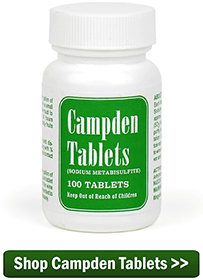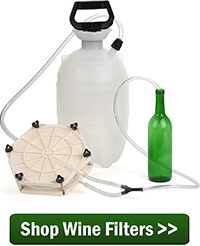 This is a subject I get about at least once a week. People are desperately interested in making sulfite free wine. Usually it is because they are suffering from headaches that they are attributing to sulfite allergies. For this reason they want to make their homemade wine without sulfites.
This is a subject I get about at least once a week. People are desperately interested in making sulfite free wine. Usually it is because they are suffering from headaches that they are attributing to sulfite allergies. For this reason they want to make their homemade wine without sulfites.
The major foil to making sulfite free wine is that sulfites are a natural byproduct of fermentation. In winemaking we talk about sulfites in terms of ppm (parts per million). Wine fermentations will naturally produce sulfites somewhere on the order of 10 to 20 ppm.
This amount may seem small, but compare it against the fact that the average bottle of wine on the market only contains about 65 ppm or the fact that any wine in the U.S. that has more than 10 ppm must have on its label, “Contains Sulfites,” then it starts to become clear that the amount of sulfites made by a fermentation is, in fact, significant to the wine’s total content.
So the answer is, “no.” You can not make sulfite free wine. There will always be some sulfite in your homemade wine. Now lets move on to the next logical question…
Can I make wines without adding sulfites?
The answer is: certainly you can. But, you should also be asking the question: do you want too? Sulfites such as Campden tablets or potassium metabisulfite are added to a wine for a reason: to keep the color and flavor fresh over time, and to keep it from outright spoiling. If the level of sulfites are too low, then it is susceptible to being overcome with bacteria, mold and other detrimental spoilers. Making sulfite free wine does not come without its own risk.
Because wine has alcohol, and alcohol is a preservative, the amount of sulfites needed to keep it from spoiling is very small as compared to amounts we find in the foods we eat everyday. Fruit juices, for example, can have on the order of 200 to 300 ppm; dehydrated fruits, conservatively around 1,000 ppm; and salsa around 1,000 to 2,000 ppm. These amounts are much higher than the 45 to 85 ppm you will typically find in wine.
With this in mind, to me it doesn’t make sense to short your wine the minuscule amount of sulfites it needs to help protect it from spoilage. And, it doesn’t make sense to blame such small amounts of sulfites on headaches when so much of it is in the foods we consume everyday. That brings us to the next logical question…
So Why Do Some People Get Headaches From Wine?
There are a certain number of people who do get headaches from drinking wine – even as little as one glass – but as explained above, automatically blaming this on sulfites is not reasonable.
Besides the fact that there is not that much sulfite in wine to begin with, there are a couple of other reasons why this doesn’t add up, as well:
- Sulfite allergies are much more rare than there are people having headaches from wine. According to medical industry reports, there are somewhere between 500 thousand to 1 million sulfite allergy sufferers in the U.S. This equals only about 1 in 300 to 600 people.
- A headache is not the primary symptom of a sulfite allergy. Asthma or having trouble breathing is the very first problem to show up.
So, What Should I do?
If you are still not convinced that sulfites are completely innocent of all charges, then you might want to consider taking better control of the sulfites. Don’t completely eliminate additions of sulfite to the wine, but lower the level of sulfites. Don’t worry about making sulfite free wine but maybe try adding less sulfites, instead.
For example, right before bottling the wine, instead of targeting a sulfite level of 55 ppm for red and 70 ppm for whites, maybe shoot for 35 ppm in reds and 50 ppm for whites. Reduce the amount of sulfites in your homemade wines. Don’t necessarily eliminate additions to your wine.
You can take readings with a Titrettor Hand Tool and Titret Test Vials. By taking control of your sulfite levels in this way, you can be certain that no more sulfites are in the wine than absolutely necessary to keep it fresh.
—–
Ed Kraus is a 3rd generation home brewer/winemaker and has been an owner of E. C. Kraus since 1999. He has been helping individuals make better wine and beer for over 25 years.

Great piece on Sulfites! Its important for people to be informed about what goes into our body’s.
Sulfites get the musty cork end of the blame game very often, when infact, most people suffer from some sort of food allergy or intolerance. Which in turn gives way to affects such as headaches.
We all hate to think that our favorite pasta dish, breads or fruit pies could possibly be the culprit.
Wine is a food. This is becoming more factual to us as the years pass. Spain has already officially declared wine a food, with more counties following suit.
Should I give up pasta or vino? hhmmm. Food for thought.
For sure I have failed to get campden. I have not understood what to do to preserve my wine. Please advise.
Excellent article! Sulfites in wine have been demonized for too long by those who do not understand how just a small amount in the wine can help a wine reach its true potential. And certainly using a stronger sulfite solution to keep the winemaking process sanitary should be in every Winemaking 101! Sulfites are your friend, and their use must be respected!
The titration test is good on whites, what about testing reds accurately?
David, there are a few ways to do this. Unfortunately, most of them require lab equipment or chemicals that no home winemaker would have or want to buy. The easiest way to go about this is to test the red wine with the Titrets. Then agitate a second sample of the wine so as to release the free SO2 gas then test that. The difference between the two test is the SO2 of the wine.
I disagree wholeheartedly and have been producing home wine with substantially less sulfites than in commercial wines. I experienced migraines following wine tastings, and was tested positive, via blood test, for sulfite sensitivity. Since then I have purchased sulfite reduced wine and regularly make sulfite reduced (no Camden tablets). Additionally, sulfite a in commercial wines can be mitigated via a very small amount if hydrogen peroxide stirred into wine 1/2 hour prior to partaking. Yes, the wine experience is unfortunately altered, but the headaches and migraines can be avoided.
My last batch of muscidine wine I used crushed Camden tablets, the color is excellent but it does seems to cause headaches. How long if ever until the sulfite levels are naturally lowered will it ever mellow out?
A. Clayton, the sulfite in the wine wants to leave as a gas if allowed, but if the wine is sealed in bottles, etc., the level of sulfite will not lower. You can decant the wine a bottle at a time and allow it sit open for an hour or so before drinking, this will release a significant amount of the sulfite.
I need simple methods to make good Wine.Problem is use of yeast(selection),quantity
Dr. Naidi, I would suggest taking a look at the 7 Easy Steps To Making Wine. This is an excellent place to start. As for yeast selection, you want to use an actual wine yeast. Within this category there are many strains that have subtle differences. While looking through our yeast selection you will see links to profile charts on the product pages to help you out in this regard.
7 Easy Steps To Making Wine
http://www.eckraus.com/wine-making-steps
Wine Yeast
http://www.eckraus.com/dry-wine-yeast?mode=grid&mode=grid
Lalvin Wine Yeast Profile Chart
http://www.eckraus.com/LalvinProfiles.htm
Most instructions I see for potassium metabisulfite state that it should be mixed with a small amount of water or wine before added to the must or wine.
Is it really necessary to do that? Why not just add the powder directly to the must or the wine?
Dewey, the reason the directions state to dissolve it first is so that it is easier to mix thoroughly into the wine.
When I have a couple glasses of Burgundy wine I get a headache and yet if I drink Merlot or Piasano I do not.
Why does one affect me and others do not?
Ken, the reason you might be experiencing headaches from drinking one type of red wine versus another could be due to the different levels of histamines, tannins or another compound in red wine.
You should also consider the level of acetic acid, or vinegar, in the wine. I am allergic to certain vinegars (yes there must be more strains, because some vinegar does not bother nearly as much!) and can get a terrible headache just minutes after consuming certain Dijon mustards, or certain wine – and I seldom get headaches otherwise.
On the other hand, my body does not like sulphites too much either – I can get somewhat dizzy and uncomfortable just by eating an egg – but ordinary, good, well kept wine that has not started becoming vinegar has never bothered me.
Thanks for the informative article.
After adding Camden tablets to the fresh juice it is my understanding that the juice is harmful to drink until the sulfur dioxide “gases out”. Is this true?
When bottling my finished wine I add small amounts of sodium meta-bisulphite (.3 grams/gal) and potassium sorbistat (.5 grams/gal). Is it safe to drink the wine immediately after adding these or should it sit for a while first?
David, the wine is safe to drink immediately after adding the campden tablets and the potassium sorbate.
i used 100% juice i will try potassium metabisulfite 1/4 tsp per 5 gallons of wine
Sulfites. Our grandparents did not know about it but they were making great wines.
We live in synthetic world, eating hormonized meat, pesticided fruits and drinking sulfitesed wine.
We are not recommended to drink water, unless it is from the bottle. We are not safe to breath
with air. We are all victims of our world. But what about the wine?
I make wine from fruits using recepy of my grandfather who was doing and drinking his wine until he passed away at his age of 102. Same with my grandma.
I am using Camden and potassium metabies just to sanitize all my wine making tool and bottles.
Just for that! The alcohol protects wine if you follow cleaning procedures.
No headache at all. Just pleasure to fill the aroma and all things your wine can give you!!!
I don’t know … I thought the author made a strong case for why you might want to use Campden in the wine must. Maybe you’ve never lost a batch to ‘disease’ or maybe it was just $20 or $30 worth of apples? What if it was $75 to $100 worth of premium Honey? Ouch. That would hurt, wouldn’t it? And I agree with the author that the trace amounts of sulfites left in the finished wine are likely NOT the cause of peoples headaches. But, as a civilian wine maker you can, of course, do what you want. Someone in the wine business probably cannot take the risk of not using sulfites. Not unless they set the business up as ‘organic’ or some other labeling that justifies their taking on the risks of depending on the law of averages for their successful outcomes. The costs now get passed on to their customers.
But this shows it can be done. What is the risk you’re talking about? what happens to some batches to spoil them, but not others?
I have read, and proven it true myself that the only times most people get a headache from wine is because they dont drink a equal amount of water. If you drink 8 onces of wine and 8 ( or more) of water most people wont get a headache. I think that allergies being so common these days is due to the horrendous diets people keep and dont even realize they are poisoning themselves daily. Like High Fructose corn sugar and Hydrogenated oils etc. ( which by the way is ONE molecule from being plastic !) Not to mention all the chemicals. Prior to 1950 none of this stuff was a issue. When I was a kid no one was allergic to peanuts and now seems everyone is. I dont think its the wine but the lifestyle.
I can drink quarts of water in a day. That night I can drink 1 glass of wine from one bottle and I’m fine. I can drink 1 glass of wine that is completely different and something in it will either give me a headache, or a headache and my back hurts right around my kidneys, either way my face will be beat red from 1 glass of wine and in the worst cases I will be finding a dark cool quiet room for about an hour and the pain (about a 7 on a scale of 10) will finally pass. Once it starts to pass, it passes quickly, but I feel very tired.
I am sensitive to some kind of tannin or something that is in some red wines and not others. I don’t know if it is the barrel they aged it in, something they added, or anything else. I usually don’t have this problem with white wines, but that isn’t to say never.
Interestingly enough (to me at least) some of the cheap wine coolers and other flavored malt beverages can do this to me with a single bottle. I rather like Mike’s Hard Lemonades, but they sure don’t like me.
So, no, I don’t think it is a matter of not drinking enough water or of diet or anything like that. When you were a kid and no one was allergic to peanuts, there actually were people allergic to them but they usually died. You know with lack of medical care, people who didn’t understand what was happening, and repeated exposures often times killed people. My dad was allergic to lima beans and at an early age my grandparents just thought he was being a picky eater. It wasn’t until years later when he could explain that his throat hurt and would swell shut when he ate them that they stopped trying to battle him to eat them.
Most research suggests that it is the histamines in red grape skins and NOT sulfite that causes the headaches. If you consider that many wine drinkers do not get headaches from white wines, which typically have higher levels of sulfite than reds, there must be something else going on. There are experiments going on replacing sulfites with other antioxidants such as condensed resveratrol, which is present in red grape skins anyway, and green tea! Condensed resveratrol not only could act as an new antioxidant, but can add more body, flavor, and aroma to wines.